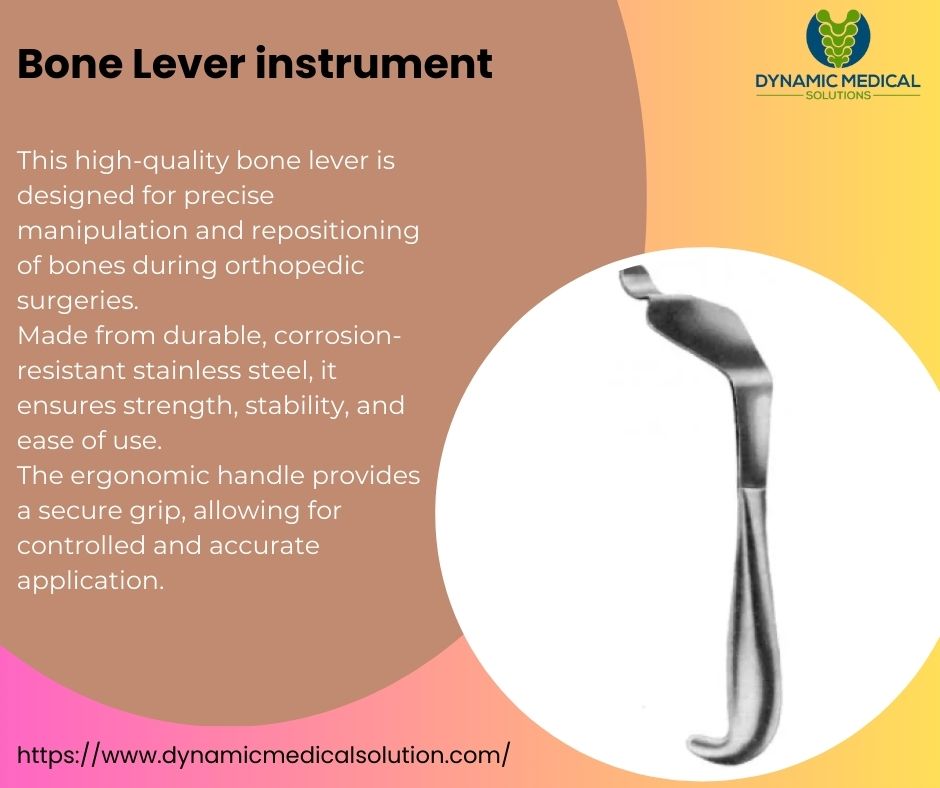Understanding the Role of Bone Lever Instruments in Surgery
Bone lever instruments are crucial tools in surgical procedures, particularly those involving the manipulation and adjustment of bones. Their design and functionality make them essential for providing the precision and stability needed in complex surgeries. This article explores the specific role of bone lever instruments, shedding light on why they are a staple in the surgical field.
What is a Bone Lever Instrument?
A bone lever instrument is a specialized surgical device used to handle, reposition, and stabilize bones during various medical procedures. Constructed from high-quality stainless steel, these instruments are designed for durability and effectiveness. Their primary function is to assist surgeons in performing intricate maneuvers on bones with minimal risk to the patient.
Key Roles of Bone Lever Instruments in Surgical Procedures
Bone lever instruments serve several critical roles in the surgical field. Below are some of the main functions that highlight their importance:
1. Providing Stability During Surgery
One of the primary roles of bone lever instruments is to offer stability during surgical procedures. When a surgeon needs to hold a bone steady, the bone lever acts as a firm anchor, ensuring that the bone remains in place. This stability is essential in maintaining accuracy, particularly in operations involving bone alignment or implant placement.
2. Enhancing Precision in Bone Manipulation
Precision is crucial when it comes to bone surgeries, and bone lever instruments are designed to facilitate that precision. Surgeons rely on these tools to make delicate adjustments to bones, whether it’s lifting a fragment, repositioning a misaligned bone, or creating space for an implant. This careful handling helps minimize trauma to surrounding tissues.
3. Assisting in Fracture Reduction
Fracture reduction, which involves the realignment of broken bones, is a complex task that requires accurate manipulation. Bone lever instruments play a key role in this process by allowing surgeons to carefully adjust and hold bones in the correct position. This stabilization is vital for ensuring proper healing and avoiding complications.
4. Facilitating Access to Surgical Sites
In many surgical procedures, gaining access to the target area can be challenging due to bone or tissue obstructions. Bone lever instruments are used to retract and hold bones out of the way, providing a clear view of the surgical site. This enhanced visibility is particularly important in operations that involve small or delicate areas.
5. Supporting Joint Reconstruction and Replacement
Bone lever instruments are indispensable in joint reconstruction and replacement surgeries. They assist in adjusting bones around the joint, allowing for precise implant placement. This accuracy is essential for the proper alignment and functioning of the artificial joint, contributing to the long-term success of the procedure.
6. Enhancing Safety in Spinal Surgery
Spinal surgery demands an exceptional level of precision due to the complexity of the spine and its surrounding structures. Bone lever instruments help surgeons manipulate vertebrae and other spinal components with great care. Their ability to hold bones securely reduces the risk of accidental movements that could harm delicate tissues or nerves.
7. Assisting in Bone Grafting Procedures
Bone grafting is a technique used to repair or rebuild bones that are damaged or missing. In these procedures, bone lever instruments help position and stabilize the graft material, ensuring it integrates correctly with the existing bone. This role is crucial in promoting proper healing and achieving a successful outcome.
8. Creating Leverage in Complex Surgeries
In surgeries that involve complex bone manipulations, bone lever instruments are used to create leverage. This leverage allows surgeons to lift, separate, or adjust bones with controlled force, making it easier to access hard-to-reach areas. The ability to apply just the right amount of force is essential for minimizing the risk of fractures or other injuries.
9. Aiding in Minimally Invasive Techniques
With the rise of minimally invasive surgical techniques, the need for precise and adaptable instruments has increased. Bone lever instruments are well-suited for these procedures, enabling surgeons to perform delicate bone adjustments through small incisions. This precision contributes to faster recovery times and better overall patient outcomes.
10. Reducing Surgical Fatigue for Surgeons
Surgical procedures can be lengthy and physically demanding for surgeons. Bone lever instruments are ergonomically designed to reduce hand fatigue, allowing for a comfortable grip during extended operations. This ergonomic advantage helps maintain surgical accuracy, even during complex and time-consuming procedures.
Conclusion: The Essential Role of Bone Lever Instruments
The role of bone lever instruments in modern surgery is extensive and essential. From providing stability and precision to enhancing safety and facilitating access, these instruments are a vital part of the surgical toolkit. As medical practices continue to advance, the importance of reliable and effective tools like bone levers remains undeniable. Their continued presence in operating rooms around the world highlights their role in ensuring successful surgical outcomes and improved patient care.For more info visit our web site Dynamic medical.


